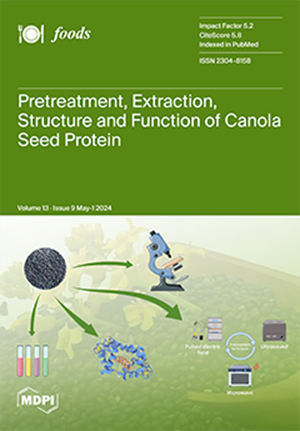Analytical Investigation of Phthalates and Heavy Metals in Edible Ice from Vending Machines Connected to the Italian Water Supply
IF 4.7
2区 农林科学
Q1 FOOD SCIENCE & TECHNOLOGY
引用次数: 0
Abstract
Edible ice is often produced by special machines that can represent a source of significant chemical and microbiological contamination. In this work, the presence of phthalic acid esters (phthalates, PAEs) and heavy metals in ice cubes distributed by 77 vending machines installed in two different zones in southern Italy and fed by water from the public water supply was investigated. Solid-phase microextraction coupled to gas chromatography−mass spectrometry (SPME-GC/MS) was used to evaluate contamination with four PAEs, which were selected because they are commonly used in the production of food-contact plastics, while inductively coupled plasma mass spectrometry (ICP/MS) was used to quantify the heavy metals. It was found that ice samples, especially those from one of the two considered zones (zone 2), exceeded the dibutyl phthalate (DBP) threshold limit value; some ice cubes from the other zone (zone 1) instead showed levels of both lead (Pb) and nickel (Ni) up to one order of magnitude higher than those observed in samples collected in zone 2 and higher than the maximum permitted values (European Directive n. 2184/2020). Since the water source connected to the ice vending machines was found to be free from significant levels of all considered target compounds and metals, the high levels of DBP, Ni, and Pb in ice cubes could be attributed to the components and/or to the state of repair of the ice vending machines themselves.意大利供水自动售货机食用冰中邻苯二甲酸盐和重金属的分析调查
食用冰通常是由特殊机器生产的,这些机器可能是严重的化学和微生物污染源。这项研究调查了意大利南部两个不同地区的 77 台自动售货机分发的冰块中邻苯二甲酸酯(PAEs)和重金属的含量。采用固相微萃取-气相色谱-质谱联用技术(SPME-GC/MS)评估了四种 PAEs 的污染情况,之所以选择这四种 PAEs 是因为它们常用于生产与食品接触的塑料,而采用电感耦合等离子体质谱联用技术(ICP/MS)则对重金属进行了定量。结果发现,冰块样本,尤其是来自两个区域之一(区域 2)的冰块样本,超过了邻苯二甲酸二丁酯(DBP)阈值限值;而来自另一个区域(区域 1)的一些冰块样本显示,铅(Pb)和镍(Ni)的含量比在区域 2 采集的样本中观察到的含量高出一个数量级,并且高于最高允许值(欧洲指令 n.2184/2020)。由于发现连接自动售冰机的水源中没有大量的目标化合物和金属,冰块中较高的 DBP、Ni 和 Pb 含量可能是由于自动售冰机本身的组件和/或维修状态造成的。
本文章由计算机程序翻译,如有差异,请以英文原文为准。
求助全文
约1分钟内获得全文
求助全文
来源期刊

Foods
Immunology and Microbiology-Microbiology
CiteScore
7.40
自引率
15.40%
发文量
3516
审稿时长
15.83 days
期刊介绍:
Foods (ISSN 2304-8158) is an international, peer-reviewed scientific open access journal which provides an advanced forum for studies related to all aspects of food research. It publishes reviews, regular research papers and short communications. Our aim is to encourage scientists, researchers, and other food professionals to publish their experimental and theoretical results in as much detail as possible or share their knowledge with as much readers unlimitedly as possible. There is no restriction on the length of the papers. The full experimental details must be provided so that the results can be reproduced. There are, in addition, unique features of this journal:
manuscripts regarding research proposals and research ideas will be particularly welcomed
electronic files or software regarding the full details of the calculation and experimental procedure, if unable to be published in a normal way, can be deposited as supplementary material
we also accept manuscripts communicating to a broader audience with regard to research projects financed with public funds
 求助内容:
求助内容: 应助结果提醒方式:
应助结果提醒方式:


